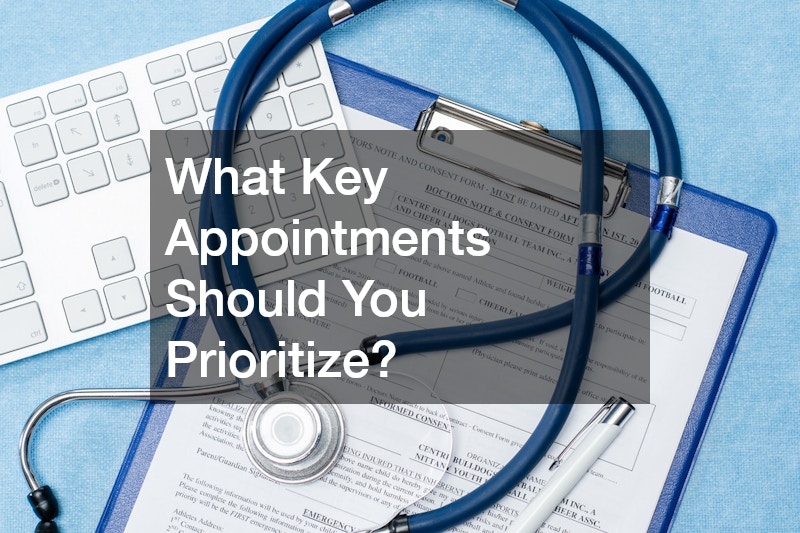
Staying healthy isn’t something that can be approached randomly or only when discomfort strikes. True wellness requires a structured, intentional schedule that ensures each aspect of your physical and mental health is consistently monitored. Creating annual, quarterly, and monthly routines helps you stay on top of changes in your body, reduces the risk of emergencies, and keeps you aligned with long-term goals. When you know exactly when your next checkup will take place, you eliminate uncertainty and make health maintenance a natural part of your lifestyle.
Smart scheduling isn’t only beneficial for managing illnesses—it’s a proactive approach that strengthens your overall well-being. By laying out a clear plan for essential visits throughout the year, you build healthier habits, reduce stress, and gain a sense of control. Whether managing your own health or coordinating a household’s worth of appointments, having a system in place is one of the most powerful tools for staying well.
1. Why Is Scheduling Health Visits Important?
Scheduling isn’t simply about filling your calendar—it’s about building a foundation for lifelong health. Establishing routine visits ensures you’re catching issues early, staying informed, and maintaining a relationship with your providers.
A. Preventive Health Care
Preventive care is the backbone of long-term wellness. Instead of waiting for pain or discomfort, routine screenings allow specialists to detect potential issues early. Services such as annual physicals, skin checks, and oral evaluations help you maintain steady health. When dental services, screenings, and checkups are spaced throughout the year, you can proactively address concerns before they escalate.
B. Early Detection of Diseases
Some conditions, including diabetes, hypertension, and certain cancers, may develop quietly without early symptoms. When you adhere to a consistent appointment schedule, doctors can identify subtle changes that may indicate underlying concerns. Even unexpected oral issues caught early may prevent the need for an emergency dentist later.
C. Consistent Monitoring of Chronic Conditions
Those with asthma, arthritis, heart disease, or other chronic conditions benefit deeply from regularly planned visits. Ongoing monitoring ensures treatments remain effective and adjust appropriately as conditions evolve.
D. Personalized Health Guidance
Every visit gives your provider a clearer picture of your health, allowing them to offer individualized guidance. Your nutrition, lifestyle, fitness, medications, and stress levels can all be evaluated and improved when you follow a dependable schedule.
E. Reducing Healthcare Costs
Preventive visits are typically more affordable than emergency care. Catching a problem early often means simpler treatment, fewer medications, and reduced long-term expenses.
2. How Often Should You Schedule Check-Ups?
Different types of appointments follow different timelines. Understanding these schedules allows you to plan strategically.
A. Annual Physical Exams
Most individuals should see their primary care physician once a year. Annual physicals act as a baseline, allowing your doctor to track changes, update medical history, and screen for potential risks.
B. Bi-Annual Dental Cleaning
Visiting dental offices twice per year is recommended for professional cleanings, cavity checks, and gum evaluations. By spacing these visits roughly six months apart, you maintain stability in your oral health.
C. Vision Screening Schedule
For adults with good vision, screenings every one to two years are normal. Those with corrective lenses, chronic diseases, or family histories of vision issues may require more frequent appointments to ensure their eyes remain healthy.
D. Frequency of Specialist Visits
Specialist visits vary depending on your needs. Dermatologists may be seen seasonally, cardiologists yearly, and wellness-focused professionals—such as those at a medical spa—may be visited quarterly for therapeutic care or lifestyle enhancements.
E. Scheduling Based on Age and Health Condition
Children, seniors, and individuals with underlying conditions often require more frequent care. Tailoring your visit schedule ensures each life stage receives appropriate attention.
3. What Key Appointments Should You Prioritize?

Certain visits should always make the top of your scheduling list, ensuring foundational healthcare remains consistent.
A. Primary Care Physician Visits
These checkups serve as the core of your wellness routine. Your primary doctor evaluates overall health, ensures medications are working, and refers you to specialists when needed.
B. Dentist and Oral Health Appointments
Dental evaluations are essential for preventing issues like decay, infections, and gum disease. Maintaining regular visits helps you avoid more serious complications down the road.
C. Vision and Eye Care Checkups
Eye health can change gradually, making regular screenings crucial. These evaluations detect issues with vision, pressure, and overall eye function.
D. Mental Health Assessments
Mental health deserves the same consistent attention as physical health. An online therapist provides accessible support for stress, anxiety, emotional changes, and overall psychological well-being, especially for individuals with busy schedules.
E. Nutritional and Dietary Consultations
Meeting with nutritionists or dietitians helps you create eating plans that support chronic conditions, weight goals, energy levels, and overall wellness.
For households with pets, parallel routines with an animal doctor ensure your pets’ health is managed with just as much care.
4. How Can Technology Assist in Scheduling?
Technology has transformed the way individuals manage appointments and health information. Using digital tools removes many barriers that once made scheduling difficult.
A. Health Apps for Scheduling Reminders
Modern health apps allow you to select appointment intervals, track medications, and receive alerts before upcoming visits. These tools help ensure you never miss a checkup.
B. Online Appointment Booking
Most clinics now allow patients to book digitally. Whether scheduling routine care or arranging pet urgent care services, online booking platforms reduce the time needed to organize appointments.
C. Electronic Health Records (EHR)
EHR systems centralize your medical information, making it easy to share records between professionals. Accessing lab results, prescriptions, and visit histories keeps you informed and organized.
D. Virtual Health Consultations
Telehealth makes it simple to connect with providers for minor questions or follow-up discussions. This reduces travel time and provides convenient access to professionals.
E. Automated Follow-Up Alerts
Many optometrists, clinics, and specialists send automated reminders through text or email. These alerts eliminate guesswork and help you plan ahead.
5. How to Handle Appointment Overlaps and Conflicts?
Busy schedules can lead to overlapping commitments. Knowing how to manage conflicts keeps your calendar organized and stress-free.
A. Prioritizing Urgent Health Needs
If sudden illness or injury occurs, visiting a walk in clinic is often the quickest solution. These facilities provide faster access to care without requiring appointments.
B. Communicating with Healthcare Providers
Most clinics understand the complexities of scheduling. Communicating openly about conflicts allows staff to help you adjust appointments effectively.
C. Utilizing a Calendar or Planner
Having a dedicated planner—digital or physical—helps you see your schedule at a glance. Color-coding types of appointments (physical, oral, eye care, etc.) can also help you stay organized.
D. Flexibility and Rescheduling Techniques
Life happens. Knowing clinic policies, having backup dates in mind, and booking during flexible periods of your day make the rescheduling process much smoother.
E. Setting Realistic Expectations for Visits
Understanding how long each visit takes prevents you from cramming multiple appointments into one time block.
6. What Are the Benefits of Proactive Scheduling?

Proactive scheduling isn’t just about avoiding missed appointments—it’s a long-term wellness strategy.
A. Improved Health Outcomes
Regular screenings and checkups offer the advantage of early detection, consistent monitoring, and timely intervention. The more frequently professionals evaluate your health, the faster they can act when something changes.
B. Reduced Stress and Anxiety
Knowing that your health needs are already planned eliminates the pressure of last-minute scheduling. People often feel more at ease when upcoming visits are accounted for.
C. Enhanced Doctor-Patient Relationship
When you see your providers regularly, trust and communication strengthen. This rapport makes it easier to discuss concerns openly.
D. Opportunities for Preventive Advice
From dental services to general health checkups, providers can offer preventive guidance that helps you avoid bigger issues later. They may recommend habits, exercises, or treatments tailored to your needs.
E. Better Health Goal Planning
If goals such as weight loss, improved heart health, or stronger immunity are part of your wellness plan, regularly scheduled visits help you stay accountable. And when unexpected issues arise—such as needing an emergency dentist—you already have a trusted provider in place.
7. How to Plan Your Visits Without Overloading Your Schedule?
A major challenge in health scheduling is avoiding burnout. You don’t want so many appointments that you feel overwhelmed or struggle to manage time.
A. Staggering Health Check-Ups
Instead of booking multiple major appointments in the same month, distribute them throughout the year. For example:
- Annual physical in January
- Vision check in April
- Dental cleaning in June
- Skin check in September
B. Considering Seasonal Health Needs
Certain appointments naturally fit certain seasons. Many people visit a medical spa in early spring for skincare renewal or relaxation before busy seasons.
C. Incorporating Wellness Activities
Pair health appointments with activities that support your well-being. Combine a checkup with a walk afterward, a relaxing evening, or even a healthy meal.
D. Avoiding Peak Times
Booking appointments during slower periods—such as midweek mornings—reduces wait times at dental offices and other clinics.
E. Importance of Time Management
Adding buffer time around appointments ensures you aren’t rushing. Extra time makes your day feel smoother and reduces stress.
8. How Can Family Health Histories Impact Scheduling?

Your family’s genetic background plays a significant role in determining how often you should see certain specialists.
A. Identifying Hereditary Health Risks
If heart disease, diabetes, or cancer runs in your family, additional screenings are essential. Early awareness helps guide your long-term scheduling plan.
B. Tailored Screening Schedules
Providers may recommend more frequent lab work or imaging based on your risk levels.
C. Communicating History to Providers
Sharing detailed history helps doctors catch hereditary issues early. Whether you’re seeing a nutritionist, therapist, or specialist, this information is invaluable.
D. Genetic Consultations and Testing
Some individuals benefit from genetic testing, which can confirm risk factors and inform screening frequency.
E. Adjusting for Lifestyle and Environmental Factors
Families with pets should also consider consistent visits to an animal doctor, while those managing emotional or mental health conditions may set up recurring sessions with an online therapist.
9. What Are the Insurance Considerations for Scheduled Visits?
Insurance plays a major role in appointment planning. Understanding coverage helps you avoid surprises.
A. Understanding Coverage Options
Review what types of visits your plan covers annually. Many preventive visits require no copay.
B. Maximizing Benefits with Preventive Care
Preventive care is often fully covered, allowing you to schedule essential screenings without financial stress.
C. Avoiding Unexpected Costs
Know your deductibles, copays, and exclusions. This prevents confusion when planning multiple visits.
D. Selecting In-Network Providers
Choosing in-network specialists, including optometrists or primary care doctors, significantly reduces out-of-pocket expenses.
E. Managing Health Savings Accounts (HSAs)
HSAs allow tax-free spending on qualified health expenses and can be used for unexpected needs—such as pet urgent care services for your animals.
10. How Can You Involve Family Members in Scheduling?

Managing health scheduling as a family creates shared responsibility and ensures everyone remains healthy through the year.
A. Encouraging Family Health Discussions
Open discussions help everyone understand their needs and stay motivated.
B. Coordinating Family Appointments
Booking checkups for multiple family members on the same day helps reduce travel time.
C. Sharing Health Goals
Families that work together—whether improving fitness, reducing stress, or focusing on eye care—build supportive habits.
D. Teaching Children About Health Maintenance
Bring children to age-appropriate visits, demonstrating how routine care works. Minor colds, fevers, or injuries can be addressed quickly at a walk in clinic.
E. Including Extended Family in Planning
Helping older relatives or siblings with busy schedules maintain their visit timeline strengthens overall family wellness.
Planning health and wellness visits throughout the year is one of the most reliable ways to stay ahead of potential issues, build healthier habits, and maintain balance in your life. With structured scheduling, you gain consistency, reduce stress, and ensure every aspect of your well-being is supported. Whether organizing routine visits, coordinating for family members, or using technology to streamline the process, a proactive approach leads to stronger long-term outcomes. By understanding your needs, prioritizing essential care, and building a year-round appointment plan, you create a foundation for a healthier and more fulfilling lifestyle.
By committing to a clear yearly plan, you create a sustainable rhythm that not only keeps you on track with essential appointments but also helps you anticipate upcoming needs, avoid last-minute scheduling stress, and maintain a steady sense of control over your personal well-being throughout every season of the year.




